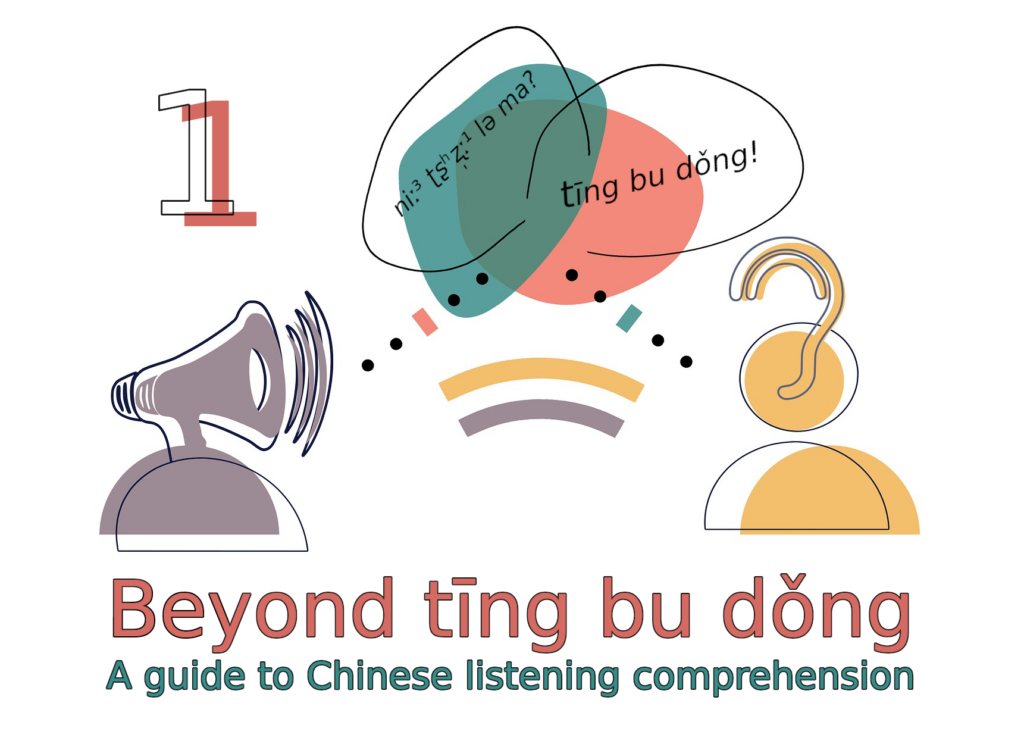Understanding spoken Chinese is challenging form most learners. There are many reasons for this, some general to listening comprehension in a second language, and some particular to Mandarin. In a survey with several hundred participants here on Hacking Chinese, listening comprehension actually came out on top as the most challenging part of learning Chinese, not speaking or writing as one might assume!
Listening ability is also the most important skill for Chinese learners. It’s a gateway to the language, because the more you understand, the more opportunities have to learn even more. Listening comprehension is also essential for integrating in a Chinese-speaking environment. Sure, speaking ability is also important, but being able to ask a question is of little use if you don’t understand the answer, and it’s hard to communicate in a meaningful way without understanding what’s going on.
Tune in to the Hacking Chinese Podcast to listen to the related episode:
Available on Apple Podcasts, Google Podcast, Overcast, Spotify, YouTube and many other platforms!
Chinese listening ability is important, yet often overlooked by students and teachers
Despite all this, both students and teachers often neglect listening ability. Formal education tends to focus on the written language, especially higher up in the system. Listening practice is often reduced to listening comprehension tests and dictation, which are woefully insufficient to prepare you for real-world listening.
While improving listening ability is largely a matter of practice (the more you listen, the more you learn), there’s more to it than that! There are many different types of listening and ways of processing spoken language, depending on the situation, the purpose of listening, the speaker, the listener and the language itself. There’s also an arsenal of listening strategies available to better deal with certain situations, along with a battery of great exercises for improving your listening ability.
Thus, the answer to a seemingly simple question like “How can I improve my listening ability in Chinese?” depends on many factors. As an independent student, learning more about listening ability and how it works will enable you to make better decisions about how you learn. Hacking Chinese has always been about encouraging and supporting independent students, referring to students who take control and responsibility for their own learning, regardless if they are enrolled in a course or not.
In this series of articles, we’re going to break down listening ability with the ultimate goal of helping you understand and overcome challenges relating to listening comprehension.
It’s time to move beyond tīng bu dǒng (听不懂)
When listening comprehension fails, most people merely note that they didn’t understand and maybe feel disappointed or frustrated because of it. However, this won’t help you improve, because each failure becomes a learning opportunity only if you understand what went wrong. While each aspect of listening ability contributes to the whole, the various components are rather different.
For example, if someone says nǐ chī le ma? (你吃了吗?), “Have you eaten?”, to you as a beginner and you fail to understand, there might be many reasons for this. Maybe….
- …you are not used to hearing tones in context and think that nǐ ought to be a dipping tone, whereas in fact it’s just a low tone here. Even though you’ve studied the word, it doesn’t sound like you’re used to and so you’re not able to connect it with your memory of the meaning of that word.
- …you’ve only learnt the word chīfàn (吃饭) before and don’t know that it can be separated into a word and an object, and that the verb can be used on its own. This type of word formation is common in Chinese, but not always transparent for language learners. I’ve written more about word formation here.
- …your understanding of the two particles le (了) and ma (吗) at the end isn’t solid enough to allow you to understand that someone is asking about a change of state. It’s one thing to learn about grammatical particles and another to be able to pick them up in natural speech, especially considering that they are often pronounced quickly.
- … you’re not familiar with the word order for questions yet.
- …the speaker has an accent you’re not used to or speaks too fast.
- …you do understand the sentence, but fail to interpret it correctly in the context it was uttered, struggling to find a way to describe your food status, without realising that the question is mostly a greeting in some contexts. This is not as widely used by younger Chinese, but it’s still common among older people (middle age and above). Younger people might just say hai (嗨), “hi”, or zuìjìn zěnme yàng? (最近怎么样), “how have you been recently”, which are easier to understand for most students.
As can be seen from the above example, listening comprehension is complex. There are two basic parts of the word: “listening” and “comprehension”, which are linked but still distinct processes. We can listen to something and process the spoken language without comprehending the intended message, but it’s also clear that comprehension is not just something extracted from sounds we hear, but an active process of interpretation and problem solving.
I have written more about the importance of analysing problems with listening ability, which overlaps partly with what I’m writing here. In the subsequent articles in this series, though, we will take a closer and more scientific look at listening comprehension. When you understand how it works, you’ll be able to guide your own learning more effectively, or if you’re a teacher, the learning of your students.
Listening in your native language vs. listening in Mandarin
When we listen to our native language, listening comprehension is quick, efficient and automatic. In fact, it works so well that we hardly ever think about it. Your cognitive resources can be used for higher-level tasks, such as thinking about what to say next in a conversation, why someone is saying something, what people are talking about in a conversation you overhear, or trying to understand the intellectual content of a podcast or lecture. People who haven’t learnt a second language seldom realise how complex listening comprehension is, exactly because it requires almost no conscious effort in one’s native language.
The complexity only becomes apparent when we learn a new language, where processing is not yet automated and anything but efficient. Since we don’t just understand automatically, we need to use our limited cognitive capacity to actively process as much as we can, and hope that this is enough to understand.
Listening is like watching a movie; reading is like looking at a picture
Listening is in some ways similar to reading, but in other ways quite different, especially in Chinese. While I’m not going to talk too much about challenges related to reading ability in this series, it’s worth noting that listening ability is harder because it takes place in real time. Halliday (1985) likened reading to looking at a picture, where you can take your time and choose to focus on one part at a time. Listening, however, is like watching a movie, where things constantly change and there’s so much going on at once that it’s impossible to take everything in at once.
Listening is harder than speaking, because as a listener, you aren’t in control. This means that the speaker chooses what to say, which words to use, how the sentences are structured and how fast they talk. In some cases, you can influence some of these factors, such as if you listening to recorded audio and reduce the speed using software (I suggest using Audacity, but many online platforms have this feature built-in, including YouTube). You can also select easier learning materials or find a person who’s willing and able to adjust their language to your level.
How to get the most out of your Chinese listening practice
This whole series is about getting more out of your listening practice by understanding how listening comprehension works, but I don’t think you should wait for me to publish all articles in the series for the most important insights. In general, three factors determine how much you learn: content, method and time, or otherwise what you do, how you do it and how much of it you do. Below, I’ve summarised what this means for listening ability, with some links to articles I’ve already written:
 What should you listen to? You should listen to Chinese at roughly your own level that contains the kind of language you want to learn. This sounds obvious, but can be very difficult in practice, especially for beginners. For example, podcasts in English (including my podcast) don’t count as listening practice, but neither does English spoken in learner podcasts. If you listen to a ten-minute episode for beginners that has a twenty second dialogue repeated a few times, plus some vocabulary and extra sentences in Chinese, but the rest is in English, this only counts as a few minutes of listening, not ten! I wrote more about this problem here: Can too much guidance make you learn less Chinese?
What should you listen to? You should listen to Chinese at roughly your own level that contains the kind of language you want to learn. This sounds obvious, but can be very difficult in practice, especially for beginners. For example, podcasts in English (including my podcast) don’t count as listening practice, but neither does English spoken in learner podcasts. If you listen to a ten-minute episode for beginners that has a twenty second dialogue repeated a few times, plus some vocabulary and extra sentences in Chinese, but the rest is in English, this only counts as a few minutes of listening, not ten! I wrote more about this problem here: Can too much guidance make you learn less Chinese? How should you listen? The goal should be both quantity and quality (not necessarily at the same time), but since the next point is entirely about quantity, let’s talk about quality first. You learn Chinese when you connect form (spoken or written words in context) to meaning and function. If you don’t understand what you’re listening to, you won’t learn much, but the more you understand, the more likely you are to pick up the few things you didn’t already know. You want comprehensible input. Furthermore, fluency development is important, so even listening to relatively easy Chinese is beneficial. The answer to the question of how you should listen is that you should vary your approach depending on circumstances. Do active listening when you can, but otherwise passive listening is good too, and when you can’t do that either, it’s still often possible to have something on in the background.
How should you listen? The goal should be both quantity and quality (not necessarily at the same time), but since the next point is entirely about quantity, let’s talk about quality first. You learn Chinese when you connect form (spoken or written words in context) to meaning and function. If you don’t understand what you’re listening to, you won’t learn much, but the more you understand, the more likely you are to pick up the few things you didn’t already know. You want comprehensible input. Furthermore, fluency development is important, so even listening to relatively easy Chinese is beneficial. The answer to the question of how you should listen is that you should vary your approach depending on circumstances. Do active listening when you can, but otherwise passive listening is good too, and when you can’t do that either, it’s still often possible to have something on in the background. How much should you listen? As much as possible! I think a reasonable goal is to listen as much as you do everything else related to Chinese combined. This includes all types of listening, including listening to Chinese music while working and the like. I’ve already linked to my article about 7 ideas for smooth and effortless Chinese listening practice, but if you struggle to integrate large amounts of listening in your life, you might benefit from shaking up how you think about time management a bit. Here’s some further reading in that domain: The forking path: A human approach to learning Chinese, The time barrel: How to find more time to study Chinese and How to find more time to practise Chinese listening.
How much should you listen? As much as possible! I think a reasonable goal is to listen as much as you do everything else related to Chinese combined. This includes all types of listening, including listening to Chinese music while working and the like. I’ve already linked to my article about 7 ideas for smooth and effortless Chinese listening practice, but if you struggle to integrate large amounts of listening in your life, you might benefit from shaking up how you think about time management a bit. Here’s some further reading in that domain: The forking path: A human approach to learning Chinese, The time barrel: How to find more time to study Chinese and How to find more time to practise Chinese listening.
Naturally, we will return to all these topics in this series, but like I said, I want this first introduction to also contain the most important information. For those who want to know more, stay tuned for the full series!
Beyond tīng bu dǒng: A guide to Chinese listening comprehension
There’s much to explore when it comes to listening comprehension in Chinese, which is why this will be a longer series of articles. Here’s a list of the articles I’ve planned for this series so far. Article tittles without links have not been published yet!
- A guide to Chinese listening comprehension
- From sound to meaning in Mandarin
- Using what you already know to aid listening comprehension in Chinese
- Learning to process spoken Mandarin quickly and effortlessly
- Becoming a better listener as a student of Chinese
- Why is listening in Chinese so hard?
- How to master different kinds of listening in Chinese
- Building an arsenal of Chinese listening strategies for every situation
- The best listening exercises to improve your Chinese
In the next two articles (part 2 and part 3), we’re going to look at how listening comprehension works by discussing two types of processing: bottom-up and top-down. These are parallel processes that we constantly rely on to understand both spoken and written language.
 Bottom-up processing is about extracting information from the spoken language. It’s about converting sound waves to speech sounds, segmenting connected speech into words and associating them to meaning, then combining words into phrases and sentences that mean something. Bottom-up processing is like using bricks to build a house. While bottom-up processing is essential for listening comprehension, it would be wrong to think that all the information you need to understand can be extracted from the Chinese you listen to. We also need top-down processing.
Bottom-up processing is about extracting information from the spoken language. It’s about converting sound waves to speech sounds, segmenting connected speech into words and associating them to meaning, then combining words into phrases and sentences that mean something. Bottom-up processing is like using bricks to build a house. While bottom-up processing is essential for listening comprehension, it would be wrong to think that all the information you need to understand can be extracted from the Chinese you listen to. We also need top-down processing. Top-down processing is about using information not present in the utterance itself (i.e. prior knowledge) to make sense of what we hear and interpret it. It’s a bit like looking at the blueprint of a house to figure out where a certain brick or piece ought to go, or know enough about architecture to realise that there should be a corridor here and a load bearing wall there, or notice that something is wrong when a room has no doors. Top-down processing is used to support bottom-down processing by limiting the number of possible options, creating hypotheses and testing them.
Top-down processing is about using information not present in the utterance itself (i.e. prior knowledge) to make sense of what we hear and interpret it. It’s a bit like looking at the blueprint of a house to figure out where a certain brick or piece ought to go, or know enough about architecture to realise that there should be a corridor here and a load bearing wall there, or notice that something is wrong when a room has no doors. Top-down processing is used to support bottom-down processing by limiting the number of possible options, creating hypotheses and testing them.
Stay tuned for the following two articles in series that will explore bottom-up and top-down processing in more detail!
Beyond tīng bu dǒng, part 2: From sound to meaning in Mandarin
References and further reading
These are the references I will use throughout this series, along with some specific ones for this article. If you only have time to read one article, I suggest Vandergrift (2011), which offers a good overview in only fifteen pages or so!
Field, J. (2009). Listening in the Language Classroom. Cambridge University Press.
Halliday, M. A. K. (1985). Spoken and written language. Deakin University Press.
Rost, M. (2011). Teaching and researching: Listening (2nd ed.). Routledge.
Vandergrift, L. (2011). Second language listening: Presage, process, product, and pedagogy. In Handbook of research in second language teaching and learning (pp. 455-471). Routledge.
Vandergrift, L., & Goh, C. (2012). Teaching and learning second language listening: Metacognition in action. Routledge.

Tips and tricks for how to learn Chinese directly in your inbox
I've been learning and teaching Chinese for more than a decade. My goal is to help you find a way of learning that works for you. Sign up to my newsletter for a 7-day crash course in how to learn, as well as weekly ideas for how to improve your learning!
